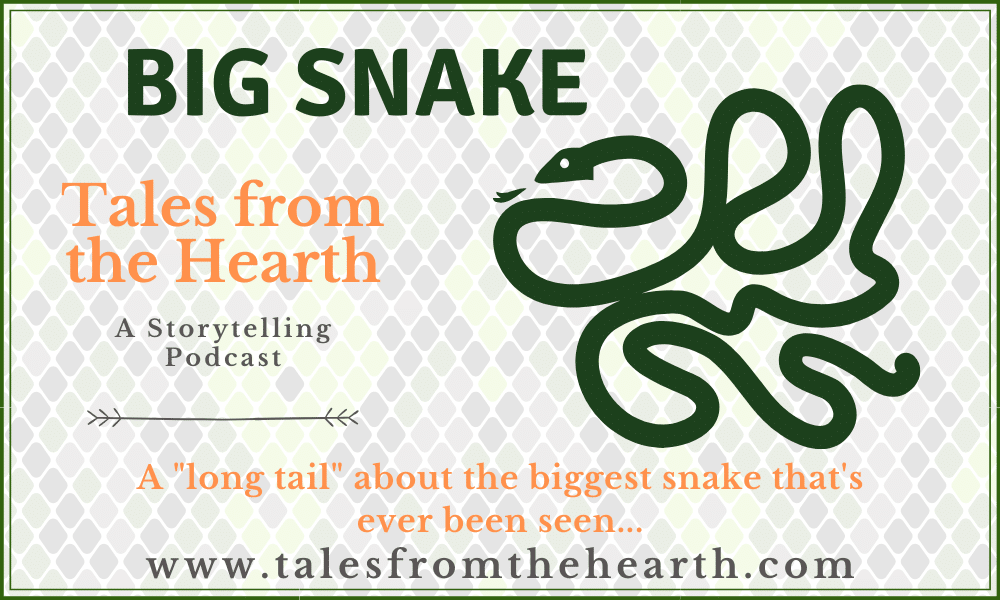Listen Now: Apple Podcasts | Google Play | Spotify | Stitcher | TuneIn
Big Snake
A “long tail” about abandoned towns, a bomb plant, and the biggest snake that’s ever been seen….
Episode Intro:
What is the largest snake you’ve ever seen? If you’re luckier, perhaps you saw it in a zoo or a serpenterium…somewhere behind the safety of a viewing glass!
I saw the largest black snake I’ve ever seen–in the wild. And I thought, “A snake that large must have one a heck of a story”. I named him “Big Snake” and created a story about him. I combined his story with the real history of the Savannah River Site near Aiken, South Carolina.
Let’s get cracklin’, shall we?
**********
Today’s episode is all about Big Snake. I literally ran into Big Snake at my place of work, and created a story in his honor. This is a tall tale, which is a greatly overexaggerated story that is hard to believe.
Because it’s about a Big Snake, you could say that it’s a “Long Tail”, that combines the history of the Savannah River Site, a former nuclear bomb plant.
So you can say that the following story is a mixture of fact and fantasy…about a real snake – the biggest one I’ve ever seen – that appeared at a place where I formerly worked. You’ll find it full of interesting facts intermingled with the stuff of science fiction stories. Or could it be real? We still don’t know the true capabilities of nuclear reactions, even though we use them routinely in reactors…that leak…and melt down…Who knows what mutations nuclear energy may cause at the cellular level?
Sources: So many! Refer to the shownotes, but the majority are taken from the srs.gov website, as well as an excellent Post and Courier article by Doug Pardue. Use the links provided in those notes to view the photos of the demolished towns and their history, it will bring this podcast to life for you.
*Update 12/28/2019* A Pinterest board of many of these photos and links are available at https://www.pinterest.com/TalesfromtheHearth/big-snake-savannah-river/
The One Takeaway I hope you get from this story: Everyone needs a friend
Now time to hear, “Big Snake”
——————————————–
In September 1949 a United States intelligence plane detected something quite unexpected—radiological markers from a Soviet bomb. As the agency had previously believed on good authority that the Communist state was years away from nuclear armament capability, this spurred government action to balance the scales.
On June 25, 1950, President Harry S. Truman, unnerved by the atomic fortification of Soviet Forces during the Cold War, gave executive orders to the E. I. du Pont de Nemours Company to build a hydrogen bomb plant in South Carolina.
**********
Big Snake hatched soon after in rural Ellenton, South Carolina. Although he was not a traditionally long black racer snake, his curiosity, propensity for mischief, and fearless forays into nearby social events earned him the nickname “Big Snake.” He enjoyed interloping into human gatherings, drawn to their jubilation and laughter.
**********
On November 28, 1950, the U.S. Atomic Energy Commission announced that the Savannah River Plant (SRP) would be built in Aiken, Barnwell, and Allendale Counties located in South Carolina. More than 200,000 acres (over 310 sq. miles) were seized by eminent domain, requiring nearly 6,000 residents (~1,500 families) to vacate their beloved properties and towns. All were given until March 1, 1952, to leave everything they had ever known—homes, farms, churches, departed family members—behind. The six South Carolina towns of Ellenton, Dunbarton, Meyers Mill, Hawthorne, Robbins, and Leigh would be leveled to accommodate the massive bomb production facilities.
Two months later on February 1, 1951, construction of the plant began.
**********
Big Snake became outraged on behalf of his displaced human friends. He was saddened at the thought that other communities around the world could be ruined and uprooted by the very same bombs made in his beloved hometown.
Big Snake echoed the reasoning of local resident Bonner Smith: “It is hard to understand why our town must be destroyed to make a bomb that will destroy someone else’s town that they love as much as we love ours. And we feel that they picked not just the best spot in the US, but in the world.”
In May 1951 the Savannah River Ecology Laboratory (SREL) began radioecological studies of Savannah River area plants and animals.
**********
Big Snake learned about the laboratory that had taken many of his family and friends…and he decided to sneak in and set them free. As Big Snake entered the live experiment area, radiation exposure turned his black scales into a dark dark green, and he began to grow and grow and grow!
**********
Construction work was booming on the new plant site, but things weren’t going so well for the workers. Their tools were going missing. Welding tanks wouldn’t spark. Literally all of the 304L and 316L stainless steel produced in the US between 1951 and 1953 went to SRS to support the construction effort, but some of it went inexplicably missing. Many swore they saw, out of the corner of their eye, a very fast-moving dark object making mischief.
The welder/brother pair Eulie and Eugene David, known for their roles as “Munchkins” in the 1939 film “The Wizard of Oz,” were driving the cloverleaf intersection one night when both swore they saw a big, long snake…so big that it had completely twirled around the entirety of a whole leaf of one of the clovers.
Eulie and Eugene were pretty shaken up, and shared this encounter with their coworkers.
The other workers made fun of them, saying, “Maybe you should go ask the Wizard for some sense. Tap your steel boots 3 times and maybe you can go back home. You know you’re not in Kansas anymore – right, fellas?”
**********
Big Snake was having soooooooo much fun.
***********
Stories and sightings of Big Snake began to spread, especially when the R Reactor went critical in 1953, followed by the P, L, and K Reactors in 1954, when irradiated fuel was also discharged – onto Big Snake, who grew and grew and grew…
The H Canyon opened in 1955 to extract plutonium and uranium. It was known as a canyon because it was 1,028 feet long, 122 feet wide, and 71 feet deep. Night shift engineer Joe Jenkins was conducting remote operations for the H canyon when he saw the longest, fastest, darkest snake he’d ever seen racing down the length of the canyon. He reckoned it was a fourth as long as that 1,028 foot long canyon! His coworkers made fun of him, claiming, “You’ve been working too many hours, Joe!”
**********
Big Snake looooved nothing more than to race down the length of those radioactive canyons.
**********
It wasn’t until years later that Joe’s sighting received substantiation. A Wackenhut Security Officer was alarmed by the frantic barking of the facility’s highly trained German Shepherds. He arrived at the site within minutes, but the dogs were at heel, slightly keening. He found nothing – until the next day, when he retrieved a 25 foot long piece of shed snakeskin! A frenzied search for the snake began after that. Many claimed to see it, but no one was ever able catch it.
**********
Big Snake was thrilled the day they announced that no more bombs would be constructed at the plant. He liked to think he had contributed to less bombs being produced through his mischief over the years. In spite of his efforts, the Savannah River Site produced about 79,366 pounds of plutonium for approximately 7,215 bombs from 1953 to 1988.
Big Snake was glad the plant’s mission had changed. It was to become a future energy center. He watched happily as the bombs and the reactive equipment and buildings were disassembled one by one.
**********
On May 25, 2010, the K reactor became the second largest cooling tower in the world to be demolished. A worker in an adjoining building said he looked down onto the roof of the building and saw a black, black, black mass spreading across the entire roof, where just the day before there had only been gray gravel.
**********
Big Snake couldn’t miss the show! Of course he was on that roof.
**********
Big Snake became nostalgic after the demolition of the cooling tower. He was nearly 70 years old. He had seen six towns full of happy people emptied and wiped off the map. He had seen everything in the bomb plant constructed, but many of those facilities were now demolished or closed. “Perhaps it’s time to leave and plan my next adventure,” he pondered.
Big Snake prepared to say goodbye. He slithered across the remaining dilapidated structures of the “dust town” of Ellenton. He heard the singing of ghosts in the town’s churches, the spinning of wheels outside its gas station, and the restlessness of the ghosts in the abandoned cemeteries where family members had not been able to visit them.
All of the animals on site came to say goodbye to Big Snake, even the radiation-resistant extremophiles who lived in the facilities’ tanks (and could live in other extreme environments such as volcanoes) – all lined up in a solemn watchful salute for his departure.
**********
The same evening the animals bid adieu to Big Snake, a Savannah River Site employee left the office as dusk was swiftly turning into night. As she approached her car, she experienced a prickly feeling that something was watching her. She turned and glimpsed three of the largest and most majestic coyotes – so large, in fact, they seemed more like the ghosts of gray wolves. They looked at the employee with such depth, such feeling, that she waved her hand to them in reverence. They didn’t acknowledge her existence, but continued to maintain their prideful watch as she drove away from the site.
The sole vehicle on the road for nearly eight miles, she finally reached the security gate exit. Suddenly, 200 yards ahead of her, she saw a large black line stretched across the two outgoing lanes. She slowed, believing it to be a road tube traffic-counting device. As she closed to within 50 yards of the black line, she swore she saw it moving.
She slammed on her brakes frantically, but the car rumbled over the wriggling black line anyway with a jolting bump-bump. She stopped and looked in her rearview mirror, but there was no longer a black line where it had once been.
**********
Big Snake glided across the four-lane road and on to his new adventure. His thick scales barely registered a double tap as he meandered across this stretch of highway for the final time.
He ruminated about where he would go and what he would do next. “Perhaps somewhere cold,” he thought, “like visiting Santa Claus at the North Pole. Or warm like Brazil, where maybe they’d accept a big snake like me.”
“What I really want,” he realized, “is to find a BIG friend to come back here and race down the canyons with me at least ONE MORE TIME.”
**********
So what are your thoughts? Are you interested in Big Snake’s next move? Perhaps he’ll meet up with Bigfoot, the Loch Ness Monster, or an Amazonian life partner? Head over to our website to let me know your thoughts.
If you’re more interested in the history of the Savannah River Site, there are great resources, including a free downloadable history book located on the srs.gov website. The site used to offer many tours each year, which I highly recommend. You can view their requirements and sign up directly on their website at srs.gov. As always, there are great links in the shownotes to view before and after photos of the demolished towns, and well as resident history and recollection.
I hope you all enjoyed Big Snake.


